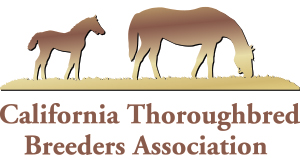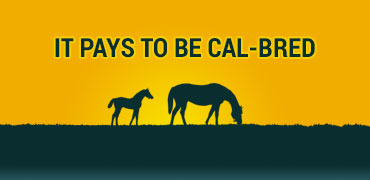By DRF.com
ARCADIA, Calif. (July 3, 2014) — The state that produced the star 3-year-old California Chrome may have a breeding industry shaking off the effects of a grueling decline in recent years.
Recent interviews with farm managers, as well as Doug Burge, the executive director of the California Thoroughbred Breeders Association, indicate that several stallions had stronger books of mares in 2014 than in past years and that some farms have had an uptick in overall activity.
Any improvement in the foal crop will be greatly appreciated by almost everyone in the sport.
California’s foal crop was 3,823 in 2002, according to The Jockey Club’s annual “Fact Book.” The 2012 foal crop, the most recent year for which statistics are available, numbered 1,685. By further comparison, the 2010 foal crop was 1,998.
Burge expects the 2014 crop to exceed 1,700, judging from conversations he has had with stallion owners and farms in recent weeks.
“What we’re seeing, and I’ve been talking to a number of farms, is that there is enthusiasm and more optimism,” Burge said. “I’m thinking we’ll see a spike in the number of mares bred this year. We had more people bringing mares to the state. Not just quantity, but quality mares, which we need with California-breds making up such a high percentage of field size in the state.”
The 2013 crop will be announced later this year.
California is not alone in suffering declines in foal crops, an international problem following the recession of the late 2000s. The North American foal crop is estimated at 23,500 for 2012, down from 28,353 in 2010 and 35,978 in 2002, according to Jockey Club statistics.
A reduction in foal crops means less business for farms and fewer breeders involved in the sport. On the racetrack, a reduction in the foal crop leads to difficulty for racetracks in attracting sufficient fields for racing. In the last five years, California tracks have reduced the number of racing days per week from five days to four. That number is not likely to be reversed in the coming years.
Despite those difficult circumstances, California horse racing had a popularity boost this year because of California Chrome.
No California stallion made more news this year than Lucky Pulpit, the sire of California Chrome. Residing at Harris Farms in Coalinga, Calif., Lucky Pulpit was bred to approximately 120 mares this year, according to farm manager Dave McGlothlin.
Lucky Pulpit was bred to 110 mares for a $2,500 fee before California Chrome won the Grade 2 San Felipe Stakes at Santa Anita in early March. He was bred to an additional 10 mares at a cost of $10,000 before his book was closed, McGlothlin said.
McGlothlin said a decision on Lucky Pulpit’s fee for 2015 will be made later this year in consultation with farm owner John Harris, stallion owner Larry Williams, and Dan Kiser, a racing manager for Williams.
Lucky Pulpit’s 2014 book size was similar to what stallions such as Cee’s Tizzy, Flying Continental, and Moscow Ballet had attracted at Harris Farms in the past. McGlothlin said other Harris Farms stallions such as Desert Code and Tizbud had larger books of mares this year than in past seasons.
“There’s more optimism, and not just solely because of Chrome,” McGlothlin said. “He may have helped people that were on the fence get back in.”
Overall, breeding activity was strong at Harris Farms, McGlothlin said.
“We delivered 172 foals, so I would say that’s a plus,” he said.
Unusual Heat, the leading stallion in the state by progeny earnings from 2008-13, was bred to 45 mares, five more than scheduled, at Harris Farms this season. The 24-year-old Unusual Heat is expected to have “41 or 42” mares in foal, McGlothlin said.
“His fertility has been exceptional,” McGlothlin said. “He had a stellar year.”
Through June 30, Lucky Pulpit led all California stallions this year with progeny earnings of $3,923,141. The late Tribal Rule was second with $2,519,700, followed by Unusual Heat with $2,182,514.
Burge said the success of California Chrome proves “good exposure for us and the [California breeding] program.”
He said the revamped Southern California racing schedule, with the addition of racing dates at Los Alamitos, is an asset following the closure of Hollywood Park last December.
“This does bring stabilization when people are making the investment knowing racing will exist,” he said.
Aside from the established sires, two first-year stallions – Champ Pegasus and Smiling Tiger – had successful seasons.
Champ Pegasus, 8, was a turf specialist, winning three graded stakes and finishing second in the 2010 Breeders’ Cup Turf. He stands at Legacy Ranch in Clements, Calif., for $3,500.
Champ Pegasus was bred to approximately 90 mares, according to farm manager Shaun Hadley. Legacy Ranch also stands multiple Grade 2 winner Papa Clem, who was bred to 46 mares this year, Hadley said.
“The second crop are 2-year-olds now,” Hadley said of Papa Clem’s progeny. “He bred close to 100 in that crop, and it tails off after that. If they run like they have, [his stud prospects] should be better.”
Smiling Tiger, a multiple Grade 1 winner who was third in the Breeders’ Cup Sprint in 2010 and 2012, was bred to more than 80 mares this year at Premier Equine Center in Oakdale, Calif.
“He was very well supported, and we had a lot of outside business from Washington and Idaho,” farm manager Graham Bell said. “We had a good response early. He was up to the task.”
Bell estimated that the national foal crop will rise as a result of this year’s breeding season.
“I know on the East Coast they are up also,” he said. “I keep in touch with guys in New York, Florida, and Kentucky.”
Not all California farms had higher breeding figures. Tom Hudson, manager at Magali Farms in Santa Ynez, described the season as “disappointing.”
“We had less mares than we’d had in the past years,” he said.
Hudson said that Grade 1 winner Coil’s book dropped from 77 during his first season at stud to the high 50s this year and that Decarchy was bred to approximately 25 mares. Decarchy, a Grade 2 winner, ranked fourth on the state’s general sire list through June 30 with $1,320,581 in progeny earnings.
At the same time, use of the Magali property has been in high demand by mare owners who want their young horses and mares in grass paddocks. California is in the midst of a severe drought, but Magali has not been as severely affected, Hudson said.
What is less clear is what impact the popularity and awareness of California Chrome will have on breeding in the state.
For the price of a student’s used car – an $8,000 mare bred to a $2,500 stallion – owners Steve Coburn and Perry Martin watched their California-bred foal win the Kentucky Derby and Preakness Stakes. It was truly a dream come true and will be nearly impossible to replicate.
Still, someone in the state could be inspired to become an owner or breeder after having watched the story unfold through the spring.
“That happened late in the breeding season,” Hadley said. “Maybe they’ll start up next year.”
Mike Allen, the farm manager at Tommy Town Thoroughbreds in Santa Ynez, estimated that the foal crop from the 2014 breeding season will be 10 percent larger than the one from the 2013 breeding season, based on activity among three veteran stallions – Kafwain, Ministers Wild Cat, and Old Topper – at his Santa Barbara County farm.
“We did better with Ministers Wild Cat,” Allen said. “He ended up with 72 [mares bred], and that’s up from last year. Kafwain had 59, and they’re getting good books. Old Topper had 15. He didn’t get much. We had [146] mares between the three stallions.”
Allen said several elements of the farm’s business have shown growth, including more horses in training at the farm and owners expressing an interest in acquiring racing stock. He said the California foal crop will not soar in future years but can show steady growth.
“If we breed 72 to Ministers Wild Cat, it would be nice to get 80 next year,” Allen said. “That would be realistic. If he has a good summer with 2-year-olds, we can do that. I don’t think we can double it unless you get [another] California Chrome.
“All the way across, it’s better,” he added. “There are some people still buying racehorses and that kind of thing.”
While California Chrome does wonders for the marketing of racing in a regional market, the attention does not immediately translate into investment. Such decisions take time.


